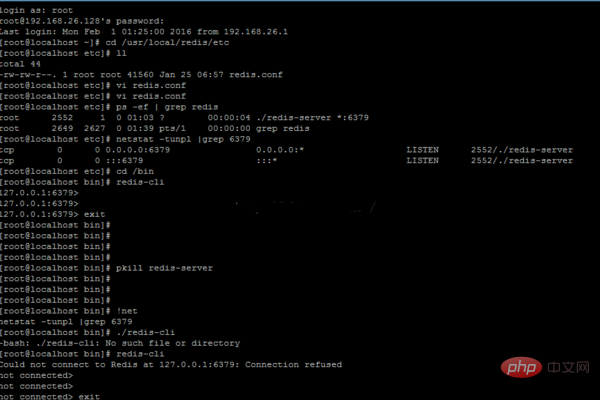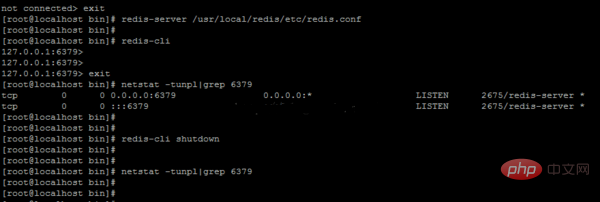How to start redis in linux

1. First, in order to facilitate management, move the conf configuration file and common commands in the Redis file into a unified file.
(1) Create bin and redis.conf files, copy the code "mkdir -p/usr/local/redis/bin; mkdir -p/usr/local/redis/ect";
(2) Execute the Linux file move command and copy the code "mv /lamp/redis-3.0.7/redis.conf /usr/local/redis/etc; cd /lamp/redis-3.0.7/src; mv mkreleasdhdr. sh redis-benchmark redis-check-aof redis-check-dump redis-cli redis-server /usr/local/redis/bin”;
2. Execute the Redis-server command to start the Redis service.

Note: The Redis service started by Redis-server is directly executed here and runs directly in the foreground (the effect is as shown above), that is to say, after executing the command, If Liunx closes the current session, the Redis service will also be shut down. Under normal circumstances, starting the Redis service requires starting it from the background and specifying the startup configuration file.
3. Start the redis service in the background.
(1) First edit the conf file, change the daemonize attribute to yes (indicating that it needs to run in the background), the code is cd etc/; Vi redis.conf;
(2) Start again redis service, and specify the startup service configuration file, the code is redis-server /usr/local/redis/etc/redis.conf;

4. After the server is started successfully , execute redis-cli to start the Redis client and check the port number.

Summary of common commands for Linux and Redis operations
1. Linux: cd /usr is to enter the upper-level folder usr from a subfolder; cd local is to enter from Parent to child; mv /A /B is to move file A to B; vi usr/local/redis/redis.conf is to edit the redis.conf file;
2. Redis: Redis-server /usr. .../redis.conf is to start the redis service and specify the configuration file; Redis-cli is to start the redis client; Pkill redis-server is to close the redis service; Redis-cli shutdown is to close the redis client: Netstat -tunpl|grep 6379 is to check the occupancy of redis default port number 6379.
For more Redis-related technical articles, please visit the Redis Tutorial column to learn!
The above is the detailed content of How to start redis in linux. For more information, please follow other related articles on the PHP Chinese website!

Hot AI Tools

Undresser.AI Undress
AI-powered app for creating realistic nude photos

AI Clothes Remover
Online AI tool for removing clothes from photos.

Undress AI Tool
Undress images for free

Clothoff.io
AI clothes remover

AI Hentai Generator
Generate AI Hentai for free.

Hot Article

Hot Tools

Notepad++7.3.1
Easy-to-use and free code editor

SublimeText3 Chinese version
Chinese version, very easy to use

Zend Studio 13.0.1
Powerful PHP integrated development environment

Dreamweaver CS6
Visual web development tools

SublimeText3 Mac version
God-level code editing software (SublimeText3)

Hot Topics
 How do I choose a shard key in Redis Cluster?
Mar 17, 2025 pm 06:55 PM
How do I choose a shard key in Redis Cluster?
Mar 17, 2025 pm 06:55 PM
The article discusses choosing shard keys in Redis Cluster, emphasizing their impact on performance, scalability, and data distribution. Key issues include ensuring even data distribution, aligning with access patterns, and avoiding common mistakes l
 How do I implement authentication and authorization in Redis?
Mar 17, 2025 pm 06:57 PM
How do I implement authentication and authorization in Redis?
Mar 17, 2025 pm 06:57 PM
The article discusses implementing authentication and authorization in Redis, focusing on enabling authentication, using ACLs, and best practices for securing Redis. It also covers managing user permissions and tools to enhance Redis security.
 How do I implement cache invalidation strategies in Redis?
Mar 17, 2025 pm 06:46 PM
How do I implement cache invalidation strategies in Redis?
Mar 17, 2025 pm 06:46 PM
The article discusses strategies for implementing and managing cache invalidation in Redis, including time-based expiration, event-driven methods, and versioning. It also covers best practices for cache expiration and tools for monitoring and automat
 How do I use Redis for job queues and background processing?
Mar 17, 2025 pm 06:51 PM
How do I use Redis for job queues and background processing?
Mar 17, 2025 pm 06:51 PM
The article discusses using Redis for job queues and background processing, detailing setup, job definition, and execution. It covers best practices like atomic operations and job prioritization, and explains how Redis enhances processing efficiency.
 How do I use Redis for pub/sub messaging?
Mar 17, 2025 pm 06:48 PM
How do I use Redis for pub/sub messaging?
Mar 17, 2025 pm 06:48 PM
The article explains how to use Redis for pub/sub messaging, covering setup, best practices, ensuring message reliability, and monitoring performance.
 How do I monitor the performance of a Redis Cluster?
Mar 17, 2025 pm 06:56 PM
How do I monitor the performance of a Redis Cluster?
Mar 17, 2025 pm 06:56 PM
Article discusses monitoring Redis Cluster performance and health using tools like Redis CLI, Redis Insight, and third-party solutions like Datadog and Prometheus.
 How do I use Redis for session management in web applications?
Mar 17, 2025 pm 06:47 PM
How do I use Redis for session management in web applications?
Mar 17, 2025 pm 06:47 PM
The article discusses using Redis for session management in web applications, detailing setup, benefits like scalability and performance, and security measures.
 How do I secure Redis against common vulnerabilities?
Mar 17, 2025 pm 06:57 PM
How do I secure Redis against common vulnerabilities?
Mar 17, 2025 pm 06:57 PM
Article discusses securing Redis against vulnerabilities, focusing on strong passwords, network binding, command disabling, authentication, encryption, updates, and monitoring.






